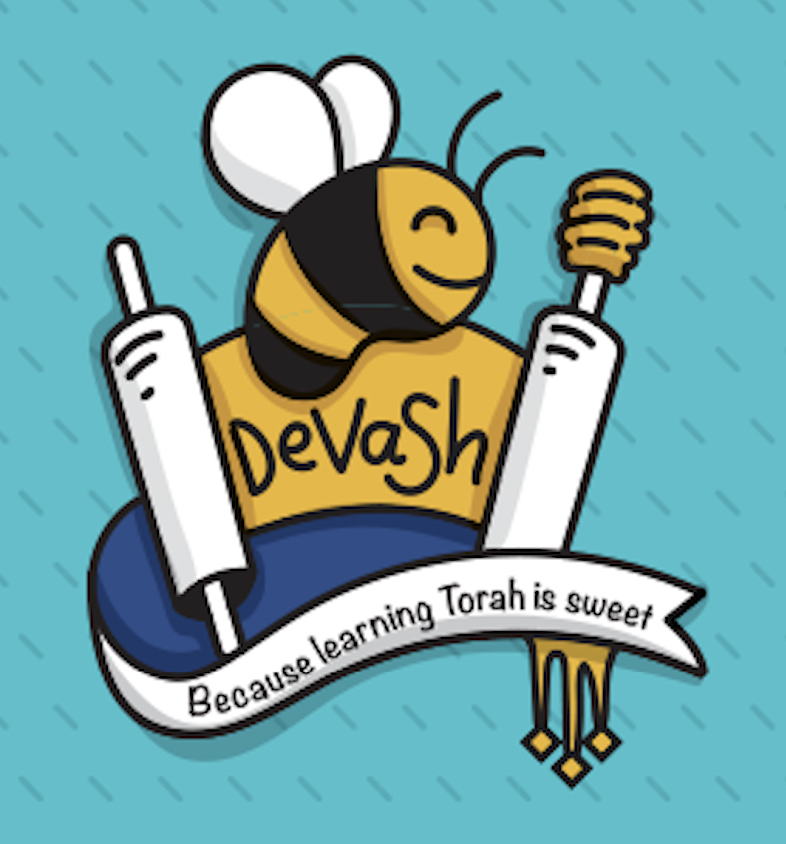
Parashah Scavenger Hunt שְׁאֵלוֹת הַשָּׁבוּעַ
Welcome to Devash's Parashah Scavenger Hunt for Parashat Tetzaveh!
Aliyah 1 (Shemot 27:20-28:12)
- How many names were on each of the stones on the shoulders of the ephod?
- Who were Aharon’s sons?
Aliyah 2 (Shemot 28:13-30)
- What was the first stone in the third row of the חֹשֶׁן (hoshen, breastplate)?
- How many gold rings did the חֹשֶׁן (hoshen, breastplate) have?
Aliyah 3 (Shemot 28:31-42)
- What words were written on the צִיץ (tzitz, the metal plate on Aharon’s forehead)?
- What piece of clothing was made with extra care, so that it wouldn’t tear?
Aliyah 4 (Shemot 29:1-18)
- Where was Moshe supposed to place the blood of the bull with his finger?
- What kind of sacrifice was the bull?
Aliyah 5 (Shemot 29:19-37)
- On which body parts of his sons did Aharon place the blood of the ram?
- For how many days did the kohanim prepare to serve in the mishkan?
Aliyah 6 (Shemot 29:38-46)
- How much wine was offered with the lamb of the עֹלַת הַתָּמִיד (olat ha-tamid, the daily sacrifice)?
- Other than the lamb, what items were part of the קָרְבַּן תָּמִיד (korban tamid, daily sacrifice)?
Aliyah 7 (Shemot 30:1-10)
- How tall was the מִזְבַּח הַקְּטֹרֶת (mizbah ha-ketoret, the golden altar used to burn incense)?
- Which two consecutive words in this aliyah are almost exactly the same – just one letter different?
Look anywhere in the parashah to find the answer to these questions!
- What three things in our parashah are described as being חֻקַּת עוֹלָם (hukkat olam, a rule for all time)?
- What shape was the חֹשֶׁן (hoshen, breastplate)?
- How many times does Moshe’s name appear in our parashah?
- Which Jewish holiday gets mentioned in our parashah?
- Which of Aharon’s garments had writing on them?
From the Haftarah
Haftarah for Zakhor: Shmuel Alef 15:1-34 for Sefaradim and 15:2-34 for Ashkenazim
- Who took pity on the animals of Amalek? (Two possible answers!)
Scroll down to see the answers!

Answers:
Aliyah 1
Aliyah 2
Aliyah 3
Aliyah 4
- קַרְנוֹת הַמִּזְבֵּחַ (karnot ha-mizbei’ah, the corners of the altar) (29:12)
- קָרְבַּן חַטָּאת (korban hattat, sin/purification offering) (29:14)
Aliyah 5
Aliyah 6
- ¼ of a הִין (hin, this equals a bit more than a quart) (29:40)
- Flour mixed with oil, and wine (29:40)
Aliyah 7
- 2 אַמּוֹת (amot, this equals about 3 feet tall) (30:2)
- לְבָתִּים לְבַדִּים (levatim levadim, as holders for the poles) (30:4)
From anywhere in the parashah
- נֵר תָּמִיד (ner tamid, continuous flame; 27:20-21); בִּגְדֵּי כְּהוּנָּה (bigdei kehunah, the special clothes for the kohanim; 28:43); the priesthood of Aharon’s descendants (29:9)
- Square (28:16)
- Zero! This is the only parashah in the books of Shemot, Vayikra, or Bemidbar that doesn’t mention Moshe by name
- Yom Kippur (30:10)
- The stones of the אֵפוֹד (ephod, a kind of apron) (28:10), the stones of the חֹשֶׁן (hoshen, breastplate) (28:21), and the צִיץ (tzitz, headband) (28:36).
Haftarah
- According to the narrator of the story, Shaul took pity (Shmuel Alef 15:9), but according to Shaul it was the entire nation that took pity (15:15)
-------------------





